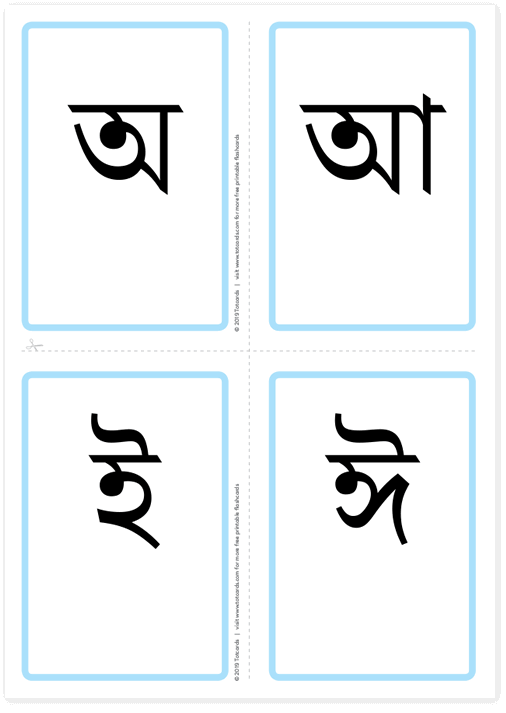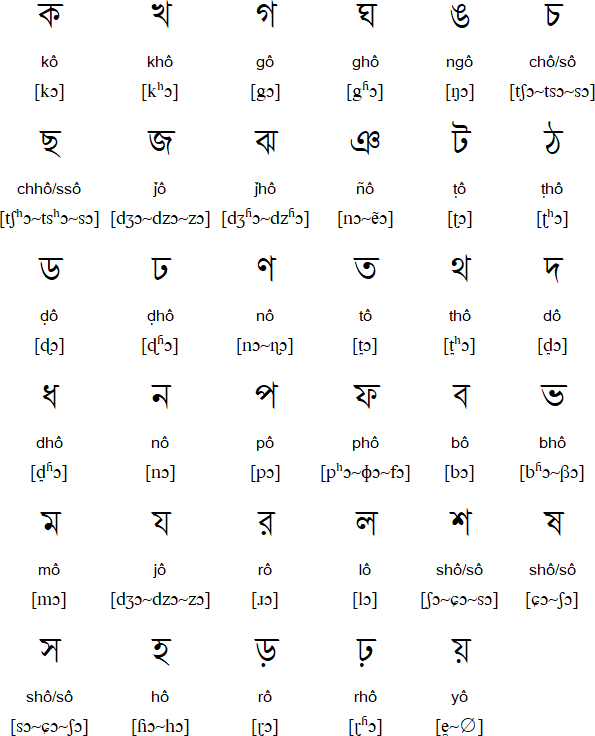

Nevertheless, it is included in the vowel section of the inventory of the Bengali script.
The grapheme called " ঋ" ṛ (or হ্রস্ব ঋ rôshshô ri, "short ri", as it used to be) does not really represent a vowel phoneme in Bengali but the consonant-vowel combination রি /ri/. These graphemes serve an etymological function, however, in preserving the original Sanskrit spelling in tôtsômô Bengali words (words borrowed from Sanskrit). The letters are preserved in the Bengali script with their traditional names despite the fact that they are no longer pronounced differently in ordinary speech. The redundancy stems from the time when this script was used to write Sanskrit, a language that had short and long vowels: " ই" i ( হ্রস্ব ই rôshshô i, "short i") /i/ and " ঈ" ī ( দীর্ঘ ঈ dirghô ī, "long ī") /iː/, and " উ" u ( হ্রস্ব উ rôshshô u) /u/ and " ঊ" ū ( দীর্ঘ ঊ dirghô ū) /uː/. There are two graphemes for the vowel sound and two graphemes for the vowel sound. As a result, the sound is orthographically realised by multiple means in modern Bengali orthography, usually using some combination of " এ" e ( স্বর এ shôrô e, "vocalic e") /e/, " অ", " আ" a ( স্বর আ shôrô a) /a/ and the যফলা jôfôla (diacritic form of the consonant grapheme য jô). Even though the open-mid front unrounded vowel /ɛ/ is one of the seven main vowel sounds in the standard Bengali language, no distinct vowel symbol has been allotted for it in the script since there is no /ɛ/ sound in Sanskrit, the primary written language when the script was conceived. Bengali, Assamese and Odia which are Eastern languages have this value for the inherent vowel, while other languages using Brahmic scripts have a for their inherent vowel. " অ" ô ( স্বর অ shôrô ô, "vocalic ô") /ɔ/ sounds as the default inherent vowel for the entire Bengali script. All of them are used in both Bengali and Assamese languages. 
The swôrôbôrnôs represent six of the seven main vowel sounds of Bengali, along with two vowel diphthongs. The Bengali script has a total of 9 vowel graphemes, each of which is called a স্বরবর্ণ swôrôbôrnô "vowel letter". Vowels & Consonant are used as alphabet and also diacritical marks. The Bengali script can be divided into vowels and vowel diacritics/marks, consonants and consonant conjuncts, diacritical and other symbols, digits, and punctuation marks.
1.9 Comparison of Bengali script with ancestral and related scripts. 1.8 Characteristics of the Bengali text. The Bengali writing system is however less blocky and presents a more sinuous shape than the Devanagari script. It is recognisable, as are other Brahmic scripts, by a distinctive horizontal line known as matra ( মাত্রা) running along the tops of the letters that links them together. 
Bengali writing system is written from left to right and use a single letter case, which make it a monocameral script, as opposed to bicameral ones like Latin alphabet. its vowel graphemes are mainly realised not as independent letters, but as diacritics modifying the vowel inherent in the base letter they are added to. įrom a classificatory point of view, the Bengali writing system is an abugida, i.e. It is one of the most widely adopted writing systems in the world (used by over 265 million people). The Bangla alphabet or Bengali alphabet ( Bengali: বাংলা বর্ণমালা, Bangla bôrṇômala) is the alphabet used to write the Bengali language based on the Bengali-Assamese script, and has historically been used to write Sanskrit within Bengal.







 0 kommentar(er)
0 kommentar(er)
